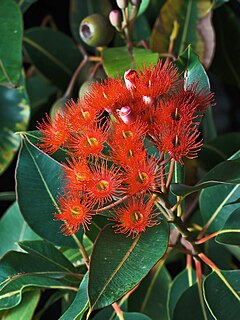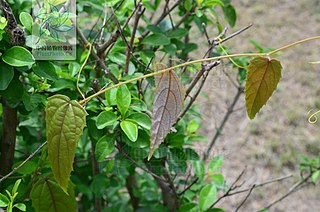
Corymbia ficifolia (syn. Eucalyptus ficifolia, commonly known as the red flowering gum, is a species of small tree that is endemic to the south-west of Western Australia. It has rough, fibrous bark on the trunk and branches, egg-shaped to broadly lance-shape adult leaves, flower buds in groups of seven, bright red, pink or orange flowers and urn-shaped fruit. It has a restricted distribution in the wild but is one of the most commonly planted ornamental eucalypts.
Vitis labrusca, the fox grape, is a species of grapevines belonging to the Vitis genus in the flowering plant family Vitaceae. The vines are native to eastern North America and are the source of many grape cultivars, including Catawba, Concord, Delaware, Isabella, Niagara, and many hybrid grape varieties such as Agawam, Alexander and Onaka. Among the characteristics of this vine species in contrast to the European wine grape Vitis vinifera are its "slip-skin" that allows the skin of the grape berries to easily slip off when squeezed, instead of crushing the pulp, and the presence of tendrils on every node of the cane. Another contrast with European vinifera is the characteristic "foxy" musk of V. labrusca, best known to most people through the Concord grape. This musk is not related to the mammalian fox, but rather to the strong, earthy aromas characteristic of the grapes that were known by early European-American settlers in the New World. The term "foxy" became a sort of catchall for the wine tasting descriptors used for these American wines that were distinct from the familiar flavors of the European viniferous wines.

Vitis riparia Michx, with common names riverbank grape or frost grape, is a vine indigenous to North America. As a climbing or trailing vine, it is widely distributed across central and eastern Canada and the central and northeastern parts of the United States, from Quebec to Texas, and eastern Montana to Nova Scotia. There are reports of isolated populations in the northwestern USA, but these are probably naturalized. It is long-lived and capable of reaching into the upper canopy of the tallest trees. It produces dark fruit that are appealing to both birds and people, and has been used extensively in commercial viticulture as grafted rootstock and in hybrid grape breeding programs.

Cucurbita ficifolia is a species of squash, grown for its edible seeds, fruit, and greens. It has many common names in English such as the fig-leaf gourd, Malabar gourd, black seed squash and cidra. Although it is closely related to other squashes in its genus, such as the pumpkin, it shows considerable biochemical difference from them and does not hybridize readily with them.

Vitis californica, with common names California wild grape, Northern California grape, and Pacific grape, is a wild grape species widespread across much of California as well as southwestern Oregon.
Vitis × doaniana is a hybrid grape resulting from the natural hybridization of Vitis mustangensis with Vitis acerifolia. Its native range is Oklahoma, Colorado, Texas, and New Mexico.

Hybrid grapes are grape varieties that are the product of a crossing of two or more Vitis species. This is in contrast to crossings between grape varieties of the same species, typically Vitis vinifera, the European grapevine. Hybrid grapes are also referred to as inter-specific crossings or "Modern Varieties." Due to their often excellent tolerance to powdery mildew, other fungal diseases, nematodes, and phylloxera, hybrid varieties have, to some extent, become a renewed focus for European breeding programs. The recently developed varieties, Rondo, and Regent are examples of newer hybrid grape varieties for European viticulturalists. Several North American breeding programs, such as those at Cornell and the University of Minnesota, focus exclusively on hybrid grapes, with active and successful programs, having created hundreds if not thousands of new varieties.

Vitis mustangensis, commonly known as the mustang grape, is a species of grape that is native to the southern United States. Its range includes parts of Mississippi, Alabama, Louisiana, Texas, and Oklahoma.

Vitis (grapevine) is a genus of 79 accepted species of vining plants in the flowering plant family Vitaceae. The genus is made up of species predominantly from the Northern Hemisphere. It is economically important as the source of grapes, both for direct consumption of the fruit and for fermentation to produce wine. The study and cultivation of grapevines is called viticulture.

Vitis davidii is a species of vining plant native to Asia. The plant grows to a height of up to 8 m (25 ft) and bears small, black grapes. It is also known as the Chinese bramble grape.

Vitis coignetiae, called crimson glory vine, is a plant belonging to the genus Vitis that is native to the temperate climes of Asia, where it can be found in the Russian Far East, (Sakhalin); Korea; and Japan. It was described botanically in 1883. It is called meoru (머루) in Korean and yama-budo (ヤマブドウ) in Japanese.
Vitis adenoclada is a species of plant in the grape family. It is found in the province of Hunan in China, where the climate is temperate.

Vitis shuttleworthii is a North American liana in the grape family commonly known as the calloose grape or bear grape. The name refers to the group of Native American people that resided in southwest FL, the Calusa. It is native to south and central Florida, with isolated populations in southern Alabama.
Vitis balansana is a species of climbing vine in the grape family native to temperate and tropical Asia. Its native range encompasses Vietnam and three southeastern provinces in China The habitat of V. balansana varies; it has adapted to living under forest cover, and in sun-soaked shrubland valleys, at between 200 and 800 meters.

Vitis flexuosa is a species of liana in the grape family.

Vitis tsoii is a species of wild grape in the family Vitaceae. It is native to the provinces of Fujian, Guangdong, and Guangxi in China, where the climate is temperate.
Vitis xunyangensis is an Old World species of wild grape native to temperate China.
Vitis heyneana is a species of climbing vine in the grape family endemic to Asia. It can be found in shrubby or forested areas, from almost sea-level, to 3200 meters above. It has globose berries that are purple to almost black.
Vitis × champinii, or Champin's grape, is a hybrid grape resulting from the natural hybridization of Vitis mustangensis with Vitis rupestris. Its native range is the Edwards Plateau in Texas.











